

Welcome to the 22nd edition of First Nations News & Views. This weekly series is one element in the “Invisible Indians” project put together by navajo and me, with assistance from the Native American Netroots Group. Last week’s edition is here. In this edition you will find a feature of Denise Juneau, the State Superintendent of Public Instruction in Montana who spoke at the Democratic National Convention, a look at the year 1886 in American Indian history, an update on the what’s happening with the Pe’ Sla land sale and a dozen linkable briefs. Click on any of the headlines below to take you directly to that section of News & Views or to any of our earlier editions.
This Week in American Indian History in 1886
~ Details of Pe’ Sla Land Deal Still Under Wraps as
Negotiations with Owners Continue ~
~ Party Platforms on Native Peoples ~
~ ACLU Wants FBI Records Targeting Indians Over Bear Hunt Opposition ~
~ Old Hurons Logo Will Be Used Inside EMU’s Band Uniforms ~
By Meteor Blades
For six minutes between the speeches last week at the Democratic National Convention of AFL-CIO President Richard Trumka and House Minority Leader Nancy Pelosi, a far less known Democrat stood at the podium in the Time Warner Cable Arena in Charlotte, North Carolina. She was Denise Juneau (Hidatsa-Mandan). One of 161 American Indian delegates at the convention, Juneau is also State Superintendent of Public Instruction in Montana, the first Native woman ever elected to statewide office in the United States. She won that four-year post in 2008 and is running this year against Sandy Welch, a Republican who says she will bring a business approach to the job. Here is Juneau’s campaign website.
She was raised on the Blackfeet reservation, took a bachelor’s degree in English at Montana State University, a master’s at the Harvard Graduate School of Education and a law degree at the University of Montana. For a while she taught English on the Fort Berthold Reservation in central-west North Dakota, home of the Three Affiliated Tribes, (Mandan, Hidatsa, and Arikara). She served as a Montana Supreme Court judicial clerk, worked briefly for a national law firm and became Director of Indian Education at Montana’s Office of Public Instruction before she was elected as superintendent four years ago.
The post makes her a voting member of the Montana State Land Board, which has considerable influence on economic development. Her opponent has received the endorsement of the Montana Chamber of Commerce based on support for opening up more state-owned Montana land to “resource development,” something Juneau has opposed. She also opposes packing more kids into classrooms, something Welch proposes to sneak under the door by decentralizing state decisions in such matters.
You can watch Juneau’s speech to the convention in the video below (or read the transcript I’ve included at the end of this piece).
Juneau’s shout-out to her mom in Charlotte was more than just the obligatory public hug. Carol Juneau is a Montana state senator and before that, from 1998-2007, served as a state representative. In her first term of office, in 1999, she got language of intent incorporated into the state’s policy of Indian Education For All. That policy had been written as part of an article into the new Montana Constitution in 1972 and then pretty much forgotten.
It says, “The state recognizes the distinct and unique cultural heritage of the American Indians and is committed in its educational goals to the preservation of their cultural heritage.”
Turning those words into something concrete took the prodigious efforts of Carol Juneau to shepherd House Bill 528-the Indian Education for All Act-through the legislature. And it took several more years of lawsuits to get it funded, according to Montana Assistant Attorney General Andrew Huff (Cree-Rocky Boy Reservation). As part of a 2004 decision in the Columbia Falls Public Schools v. State, a district court ruling later upheld by the Montana Supreme Court found that Montana had shown “no commitment in its educational goals to preservation of American Indian cultural identity.” Consequently, additional funding was provided to public schools to meet this and other commitments.
In an interview with Indian Country Today, Denise Juneau discussed the law’s implementation:
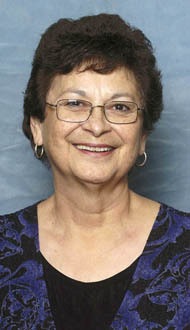
Can you explain Carol Juneau, your mother’s, connection and involvement in IEFA?
[A]s a state representative she was the one in 1999 who got the intent behind the constitutional language put in the statute, and that’s where a lot of the [Columbia Falls] lawsuit came from. There were three things the constitutional language meant: all personnel have an understanding of American Indians; every Montanan be encouraged to learn about American Indians; and where there are areas that need IEFA implementation, we constantly strive to improve it. She was the one who was able to move that forward, work it through a Republican governor and a lot of Republicans in the legislature, and really bring it to the forefront and get it passed.
What do you tell teachers to convince them of the importance of IEFA?
I used to be the director of Indian Education so I worked with a lot of teachers personally. We always had a philosophy we used since the beginning. There would be no blame, shame, or guilt in any of our training. People can’t help if they don’t know about American Indians when they weren’t taught it in school, or just know how the media portrays Indians. It’s not their fault, and we don’t want to walk in a room and wave fingers at them. We really want to take the philosophy that when we move forward, we do it in a very positive way. We need to take teachers and adult learners from where they are and build from their current knowledge and strengths. We look beyond “blame, shame, and guilt,” and say, “These are the facts, this is the way our country and Indian history is,” then lay it out and have discussions.
As FNN&V reported in May, surviving delegates to the convention that rewrote Montana’s constitution joined with other Montanans late this spring to commemorate the 40th anniversary of its passage.
One of the speakers was Assistant Attorney General Huff:
Because he didn’t look obviously like an Indian or what other people thought an Indian should look like, many people thought Huff was Italian or Mexican or marveled at his apparent easy ability to tan.
“So by the time I had hit high school in Missoula, I’d heard just about it all with regard to Indians-all the Indian slurs, the stereotypes, the racial epithets,” he said. “I’d heard that Indians were drunk, lazy, that we were a defeated people, that we should just blend in, that we should accept our fate and assimilate and that reservations should be done away with.”
Many people in his life-his supportive family, many teachers and his friends-had fought against these stereotypes, Huff said. Many people wanted to help Indian children, but lacked the knowledge to counter the stereotypes, he said.
It took 40 years, but Montana at last is fulfilling the promise of that provision, Huff said.
Montana has a K-12 Indian Education for All curriculum, developed in consultation with Indians and their tribes, he said. Teachers are getting trained on how to teach it and learn about Indians and Indian tribes. And Montana children of all backgrounds are learning about Indians and their history.
IEFA is making a difference not just in informing all students about Indians but providing an education that gives Indian students from Montana’s 12 tribes dignity in the classroom. That, educators hope, will improve the ghastly Indian dropout rate. Although about 11 percent of public school students in grades 7 to 12 in Montana are Indian, in the past five years Indians comprised 48.6 percent of dropouts in grades 7 to 8, and 23.8 percent of all high school dropouts. Only 59.3 percent of Indian students graduated. The bigger the school, the worse the dropout rate.
IEFA has already improved the morale of Indian students, according to a number of educators:
Thanks to the curriculum funded by IEFA, those Indian students now feel less alienated. School counselor Marcia Beaumont [Blackfeet] spent 22 years working in rural reservation schools before moving to a Billings middle school 10 years ago. She says about IEFA’s impact: “For kids who have a real solid identity with their tribe, they’re happy about it because they’re like, ‘Finally I’m sitting in a class and a teacher acknowledges I exist, and I’m unique and that I’m Native American and not like every other kid in the class.’ ”
Says Juneau: “Knowing that every tribe’s cultural practices and histories are different, what could be common things tribes want people to know about them? [We] were able to create an ‘essential understandings’ [document] that still forms the basis of everything we do.”
Mike Jetty (Spirit Lake Dakota Nation) is the Indian education specialist for the Montana Office of Public Instruction. He says the hope is that the implementation of IEFA will promote better understanding. “We can’t let these goofy divisions keep us apart. Students from across the state will understand what tribal sovereignty is, and the government-to-government relationship with tribes. I think the future leaders of Montana are going to have a better understanding of Indian-white relations, and we can move forward together.”

Here is the transcript of Juneau’s convention speech:
Wow! It is such an honor to be here tonight all the way from Big Sky Country. I am proud to be here as a Montanan, as an educator, as a Democrat, and as a member of the Mandan and Hidatsa tribes. And I’m proud to be the first Native American woman in history to win a statewide election.
My parents told me that education was the path to success-and they showed me, taking me to Head Start while they were pursuing their own college degrees. My mom is here tonight as a Montana delegate. Thank you, Mom.
Essential to my success were the teachers who invested their time and talent in me so I could go from high school on the Blackfeet Indian Reservation to Montana State University, Harvard Graduate School, and law school at the University of Montana. Teachers do the noble work of educating our children. And we can’t thank them enough for the hard work they put in every day to ensure a bright future for all of us. Thank you, educators.
As a teacher, I was an advocate for my students and their success. Now, as Superintendent of Public Instruction in Montana, I have the honor to be the top advocate for the education of all of our state’s children.
As Democrats, we believe that every child-regardless of background or ability-is entitled to an excellent education. Our determination to strengthen our schools to provide a 21st century education for every child compels us to work to re-elect President Barack Obama. Our commitment to create jobs for the American people and to grow our economy from the middle out drives our determination to re-elect the president.
President Obama knows that education is the best investment an individual can make in themselves, that a family can make in its children, and that a nation can make in its people. That’s why he has made historic investments in higher education, making college more affordable-from community colleges to Pell Grant scholarships and student loans.
President Obama knows that the value of education is not just in the equations our students memorize or the books they read. For some students, school is the only place where they get a hot meal and a warm hug. Teachers are sometimes the only ones who tell our children they can go from an Indian reservation to the Ivy League, from the home of a struggling single mom to the White House.
Our schools are where we pass down our stories and our history. And in my family, that American history goes back centuries-back to the first residents: Native Americans.
President Obama understands that the Native American story includes both painful chapters and hopeful ones. He knows that the Native American story is part of America’s story and that we deserve to be part of the American dream. That is why he welcomed the tribal nations to the White House and joined them at the table. He signed the Cobell Settlement to correct a long-standing injustice that the late Elouise Cobell-a warrior woman-spent 15 long years fighting for. He’s made investments to prevent violence against women in Native communities and to increase opportunities for our youth and veterans. And when he brought health care to all Americans, he helped build hospitals, train nurses, and ensure healthy moms and healthy babies in tribal communities.
It was a proud day in Montana when President Obama visited the Crow Nation and became an adopted Crow tribal member. In fact, I think there are a few of his Crow relatives here tonight. He was given a Crow name that day-it translates to “one who helps people throughout the land.” That is more than an adopted name; that is at the core of who he is. It is his mission. And that’s why, this November, we will re-elect President Barack Obama!

By Meteor Blades
On Sept. 4, 1886, Geronimo and His Band Surrendered
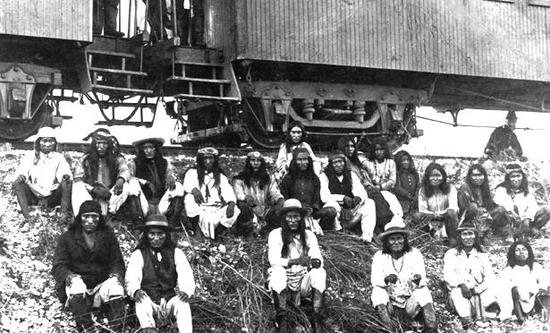
Chiricahua Apache prisoners at a rest stop beside the Southern Pacific Railway,
near Nueces River, Tex., Sept. 10, 1886. Among those on their way
to exile in Florida are Natchez (center front) and, to the right,
Geronimo and his son in matching shirts.
After 30 years fighting to maintain a traditional Apache way of life, Goyahkla gave himself up to Brigadier General Nelson Miles in Skeleton Canyon, Arizona, on Sept. 4, 1886. Known to the non-Indian world as Geronimo, the twice-captive Chiricahua Apache leader was the last Indian war chief to formally surrender to the United States. Though undefeated, he and his small battered band had grown weary after years of outwitting their pursuers. He agreed in negotiations with someone he respected, Lt. Charles Gatewood, to give up, first to Captain H.W. Lawton and then to the ambitious Miles.
Within a few days, the general had shipped Geronimo, the 35 men young enough to be warriors in his band and the Chiricahua scouts who had helped track him off to prisons in Florida, Alabama and, finally to Fort Sill in Oklahoma. Geronimo died there in 1909 from complications of pneumonia contracted in a hospital after being thrown from his horse. He was 80.
The History Channel website contains a brief, riddled-with-factual-errors account of his surrender and subsequent life. Included is the ludicrous statement that he never learned how to shoot a gun, something his contemporaries certainly did not agree with. When he surrendered, after all, he was carrying a Winchester rifle now displayed at the military academy at West Point. Here is a photo of it. He also was carrying a nickel-plated Colt revolver in a fabulous holster and belt rig covered with silver conchos, now on display at the Fort Sill museum.
Although technically still a prisoner, Goyahkla became a minor celebrity and spent much time traveling around the country in his latter days. He signed autographs and told stories to tourists at the Louisiana Purchase Exposition in St. Louis in 1904 and was an invited guest at the inauguration of Theodore Roosevelt in 1905. He once pleaded, “Let me die in my own country, an old man who has been punished enough and is free,” but he was never allowed to return to Arizona. His obituary in The New York Times can be found here, filled with errors, fabrications, slurs, idiocies, and many stereotypes that we still have with us.

Details of Pe’ Sla Land Deal Still Under Wraps as Negotiations with Owners Continue
By Meteor Blades
Mahpiya holds the poster designed by Shepard Fairey to support the purchase of Pe’ Sla in the Black Hills at a rally held in Rapid City on Sept. 5, 2012.
Some 250 supporters of Sioux efforts to buy a 2000-acre piece of land in the heart of the Black Hills rallied Wednesday, Sept. 5, in Rapid City, South Dakota, to celebrate their second victory. The first was to stop a public auction of the land they call sacred, the second was reaching a preliminary agreement with the land owners and coming up with enough money for a down payment. What happens next is uncertain.
The specifics of the final price have not been released publicly by either the Rosebud Sioux Tribe, which has been carrying on the negotiations, or the owners, Leonard and Margaret Reynolds. The tribe put up $1.3 million for the land they call Pe’ Sla, and the Last Real Indians had raised more than $300,000 when the preliminary deal was made. As of the time this diary was written, they had raised $389,000. Besides the private donations and the Rosebud Sioux’s pledge, other tribes of the Oceti Sakowin, the Seven Council Fires of the Great Sioux Nation, have said they will contribute, but none has made the amount publicly known. If $6 million, the lowest estimate of what the auction was estimated to have brought, is what is agreed upon, more than $4.3 million is still needed.
Ruth Hopkins (Sisseton-Wahpeton/Mdewakanton/Hunkpapa) of Last Real Indians explained recently why buying this land matters:
To the Oceti Sakowin [the Seven Council Fires of the Great Sioux Nation], Pe’ Sla is The Heart of Everything. Not only does this sacred site play a key role in our creation story, it is said to be the place where The Morning Star plunged to earth, and saved the People from seven creatures who had killed seven women. The Lakota hero then placed those women in the night sky as “The Seven Sisters,” called “The Pleiades” by western astronomers.
The core of the Pe’ Sla acreage was homesteaded in 1876 by Leonard Reynolds’s great-grandfather when the land was the property, under the provisions of the Fort Laramie Treaty of 1868, of the tribes of the Great Sioux Nation. In the wake of the battle of the Little Big Horn, Congress broke the treaty, taking the Black Hills and other lands. In 1980, the U.S. Supreme Court ruled that the land had been taken illegally and ordered $17.5 million in compensation plus more than a century of interest for a total of $106 million. But the tribes unanimously rejected the money, fearing that accepting it would mean they would forever lose the Black Hills. Compound interest over three decades has turned that money, held in trust, into an accumulation of more than $1.5 billion.
On display at the Rapid City rally was a 20-foot by 80-foot banner by artist Shepard Fairey depicting an young Oglala dancer and the words, “The Black Hills Are Not For Sale,” and photographs by Aaron Huey, whose images from the Pine Ridge Reservation of South Dakota were included in a cover story in National Geographic magazine.
One speaker at the Rapid City rally, Chase Iron Eyes (Standing Rock Sioux)-the founder of Last Real Indians who initiated the fund-raising project after the auction was announced-expressed cautious optimism: “The Rosebud Sioux Tribe has placed earnest money down towards the purchase of Pe’ Sla, but it is not a victory yet-the fight isn’t over. But, this is a huge success, because it buys us time.”
Robin Lebeau, tribal councilwoman from the Cheyenne River Reservation, urged continuing unity in the effort to ensure that Pe’ Sla does not fall into the hands of developers: “Something historic has happened. We have united as the Lakota, Dakota, and Nakota people when some said that we wouldn’t come together […] I’m asking you [fellow tribal members] to call your presidents, your chairmen, your spiritual leaders, your treaty groups. We have to keep working to come together for Pe’ Sla.”

• Native American DNC Delegates Say Obama Speech “Electric”: At least 161 American Indian delegates attended the Democratic National Convention in Charlotte, North Carolina, last week. They far outnumbered all previous delegate turnouts at the party’s conventions. Five of Montana’s 31 delegates, for example, were Indian: state Sen. Sharon Stewart-Peregoy (Crow), Latonna Old Elk (Crow), Catherine “Buffy” Stewart (Crow), state Sen. Carol Juneau (Hidatsa-Mandan) and her daughter, State Superintendent of Public Instruction Denise Juneau (Hidatsa-Mandan), the first American Indian woman ever elected to statewide office in the United States. Also included were two tribal chairmen, Mark Macarro, the chairman of the Pechanga Band of Luiseño Indians, and Bill John Baker, the principal chief of the Cherokee Nation.
Nina Fowler (Navajo) told National Native News radio: “Goodness, this is so energizing […] and the thickness of the excitement in this place is amazing. It’s like just a big party. […] Indian Country is really in a lot of ways federal laws and just are really tangled up. And [Obama has] got to untangle them in order for him to help Indian Country. But he has been able to accomplish a lot.”
-Meteor Blades
• Indian at Dem Convention Says Elizabeth Warren Should Take DNA Test : Ever since the right-wing Boston Herald dug into Massachusetts Senate candidate Elizabeth Warren’s claims that she has Cherokee and possibly Delaware (Lenape) ancestry, some Indians have sought an audience with her to ask that she either verify the claims or repudiate them and apologize. She has chosen not to meet with them and she did the same at the Democratic Convention last week. Some Indian delegates at the convention told The New York Times that she could easily set the whole controversy to rest. Karen Geronimo (Mescalero Apache), whose husband Harlyn Geronimo is a great-grandson of the famous 19th Century warrior, said, “”Someone needs to make her take a DNA test.” Said Lexie LaMere (Winnebago), a Nebraska delegate: “If you’re going to be Native, don’t just be Native on paper. What’s troubling is that she’s shown nothing in her history of being involved in Native American issues.”
-Meteor Blades
• Party Platforms on Native Peoples: Here is what the Democrats have to say:
Tribal Sovereignty: American Indian and Alaska Native tribes are sovereign self-governing communities, with a unique government-to-government relationship with the United States. President Obama and Democrats in Congress, working with tribes, have taken unprecedented steps to resolve long-standing conflicts, finally coming to a resolution on litigation-some dating back nearly 100 years-related to management of Indian trust resources, administration of loan programs, and water rights.
The President worked with Democrats to pass the HEARTH Act to promote greater tribal self-determination and create jobs in Indian Country. The Affordable Care Act permanently reauthorized the Indian Health Care Improvement Act to improve care for Native Americans. Democrats enacted the Tribal Law and Order Act, support expansion of the Violence Against Women Act to include greater protection for women on tribal lands, and oppose versions of the Violence Against Women Act that do not include these critical provisions. We will continue to honor our treaty and trust obligations and respect cultural rights, including greater support for American Indian and Alaska Native languages. Democrats support maximizing tribal self-governance, including efforts for self-determination and sovereignty of Native Hawaiians.
Here is what Republicans have to say:
Honoring Our Relationship with American Indians
Based on both treaty and other law, the federal government has a unique government-to-government relationship with and trust responsibility for Indian Tribal Governments and American Indians and Alaska Natives. These obligations have not been sufficiently honored. The social and economic problems that plague Indian country have grown worse over the last several decades; we must reverse that trend. Ineffective federal programs deprive American Indians of the services they need, and long-term failures threaten to undermine tribal sovereignty itself.
American Indians have established elected tribal governments to carry out the public policies of the tribe, administer services to its tribal member constituents, and manage relations with federal, State, and local governments. We respect the tribal governments as the voice of their communities and encourage federal, State, and local governments to heed those voices in developing programs and partnerships to improve the quality of life for American Indians and their neighbors in their communities.
Republicans believe that economic self-sufficiency is the ultimate answer to the challenges confronting Indian country. We believe that tribal governments and their communities, not Washington bureaucracies, are best situated to craft solutions that will end systemic problems that create poverty and disenfranchisement. Just as the federal government should not burden States with regulations, it should not stifle the development of resources within the reservations, which need federal assistance to advance their commerce nationally through roads and technology. Federal and State regulations that thwart job creation must be withdrawn or redrawn so that tribal governments acting on behalf of American Indians are not disadvantaged. It is especially egregious that the Democratic Party has persistently undermined tribal sovereignty in order to provide advantage to union bosses in the tribal workplace.
Republicans recognize that each tribe has the right of consultation before any new regulatory policy is implemented on tribal land. To the extent possible, such consultation should take place in Indian country with the tribal government and its members. Before promulgating and imposing any new laws or regulations affecting trust land or members, the federal government should encourage Indian tribes to develop their own policies to achieve program objectives, and should defer to tribes to develop their own standards, or standards in conjunction with State governments.
Republicans reject a one-size-fits-all approach to federal-tribal-State partnerships and will work to expand local autonomy where tribal governments seek it. Better partnerships will help us to expand economic opportunity, deliver top-flight education to future generations, modernize and improve the Indian Health Service to make it more responsive to local needs, and build essential infrastructure in Indian country in cooperation with tribal neighbors. Our approach is to empower American Indians, through tribal self-determination and self-governance policies, to develop their greatest assets, human resources and the rich natural resources on their lands, without undue federal interference.
Like all Americans, American Indians want safe communities for their families; but inadequate resources and neglect have, over time, allowed criminal activities to plague Indian country. To protect everyone-and especially the most vulnerable: children, women, and elders-the legal system in tribal communities must provide stability and protect property rights. Everyone’s due process and civil rights must be safeguarded.
We support efforts to ensure equitable participation in federal programs by American Indians, including Alaska Natives, and Native Hawaiians and to preserve their culture and languages that we consider to be national treasures. Lastly, we recognize that American Indians have responded to the call for military service in percentage numbers far greater than have other groups of Americans. We honor that commitment, loyalty, and sacrifice of all American Indians serving in the military today and in years past and will ensure that all veterans and their families receive the care and respect they have earned through their loyal service to America.
• Oglala Lakota Alternative Rock Duo “Scatter Their Own” Performs at Pe’ Sla Rally

Juliana BrownEyes and Scotti Cliff (both Oglala Lakota) from Pine Ridge reservation in South Dakota believe that music is about and for the people. Lyrically, they pay tribute to the concepts and philosophy of their Lakota culture while fusing Rock, R&B, Blues, and Alternative, into what they would like to call Alter-Native Rock. Their influrences are family; Black Elk, Sitting Bull, Crazy Horse, Red Cloud, Hobert Pourier, C.L. Johnson, Gandhi, John Lennon, Bob Marley, Marvin Gaye, Jimi Hendrix and Buddy Red Bow. A taste of their music can be enjoyed here.
-navajo
• Author Alexie Will Vote for Obama Though He’s Not Thrilled: Sherman Alexie (Spokane/Coeur d’Alene), the acclaimed author, poet and screenwriter, isn’t very impressed with what President Obama has done for Indians. At the website 90 Days, 90 Reasons (to vote for Obama), Alexie writes, Because the liberal Messiah does not exist: “I tried to think of one great thing Obama has done for Indians. And I couldn’t think of one damn thing.” Alexie, nevertheless, will vote for him, he says: “To love him, I only need to believe in 51% of what he does. And, hey, I’d guess I believe in 63% of what he does.” Alexie might consider doing a little research on what Obama has done for Indians. He could start with Aji’s essay here, for example.
-Meteor Blades
• Cherokee GOP Candidate for Congress Hates Stimulus, Gets $370,000 from It: Republican Markwayne Mullins (Cherokee Nation) is seeking the 2nd Congressional District seat in Oklahoma that is now occupied by Democrat Dan Boren, who is leaving Congress this year to work for the Choctaws. Mullins says he “totally disagrees” with the stimulus act, the American Recovery and Reinvestment Act. Mullins’s campaign has made a big deal out of reining in government spending. But his plumbing business received $370,000 provided by the stimulus. That came about because he is a enrolled member of the Cherokee Nation, which gives preferential bidding rights to tribal members. The projects he won bids on were funded by the stimulus. Mullins claims he had “no clue” about the source of the money.
If Mullins wins, he will be the second tribally enrolled Indian currently in Congress from Oklahoma. Tom Cole, an enrolled Chickasaw, represents the 4th District. He is also a Republican. The Cherokee Nation has contributed $2,500 to Mullins’s Democratic opponent, Rob Wallace.
-Meteor Blades
• ACLU Wants FBI Records Targeting Indians Over Bear Hunt Opposition: American Indians are part of a coalition that opposes bear hunting in Nevada. As FNN&V reported in March, one of them, Raquel Arthur (Pyramid Lake Paiute), objected when, at a public hearing, the chairman of the Washoe County wildlife advisory board, Rex Flowers, told a group of eight Paiute, Washoe and Shoshone that he didn’t want to “hear of bows and arrows” because the board was committed to the bear hunt. He later apologized for the remark, saying that he didn’t mean to disparage Indians.
Arthur, chairwoman of the northern Nevada chapter of the American Indian Movement, is one of three Nevada AIM members who were targeted by the FBI because of their opposition to the hunt, which is organized by the coalition No Bear Hunt. The others are Lisa Bonta (Reno-Sparks Indian Colony) and Daniel Thayer (Northern Paiute). FBI Agent George Chillito, who is on the Task Force on Counter-Terrorism in Reno, is said to have been investigating the three at the request of Nevada Department of Wildlife game wardens who said they and the “audience felt threatened” by the presence of Indians at the board meeting.
The ACLU filed a Freedom of Information Act request Aug. 22 to learn what the FBI has been reporting regarding the three Indians and anyone else the bureau may have included in its investigation related to the opposition to the hunt. Nevada will allow up to 20 black bears to be killed between Sept. 15 and the end of 2012. The objective of the FOIA request is to support the freedom of speech rights of the foes of the hunt, an ACLU attorney involved in the case told the Associated Press.
-Meteor Blades
• Wolakota – Friendship with the Lakota Nation Exhibit in Italy:
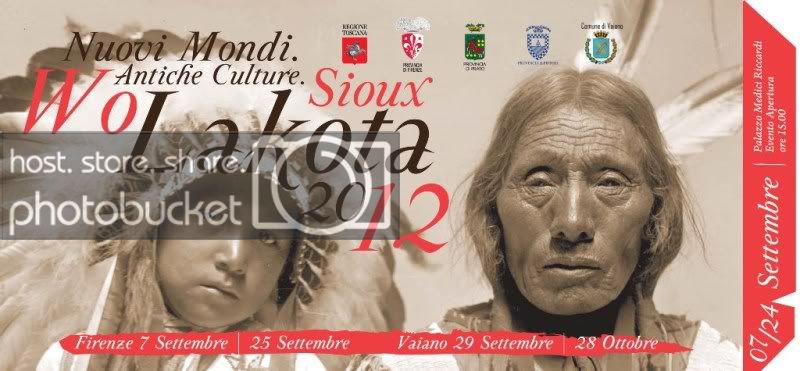
The Palazzo Medici Riccardi in Florence, Italy is currently running an exhibit titled: Wolakota 2012: Ancient Culture in the New World. Wolakota translates from Lakota to friendship with the Lakota Nation. On display will be Indian artifacts, weapons, clothing, wapaha (feather head-dresses), a tipi and a Remington gun found in 1860 in the area of the Battle of the Greasy Grass (Little Big Horn). Live music and sage smudging will finish the cultural exhibit. One of the organizers, the cultural association Wambli Gleska was organized in 1995 by Dr. Alessandro Martire to promote recognition of the human rights of the Lakota Sioux in Italy. Dr. Martire will be giving a special presentation based on his book, Nuovo Mondo (New World), Genocide, Ecocide and Ethnocide of the Discovery of the New World: The Horrors, Errors and Furies. The exhibit runs from September 9-25.
-navajo h/t racheltracks
• “Moving Camp” Helps Dozens of Native College Students Get Settled: Transitions can be tough for American Indian students away from home for the first time. That’s true of all young people, of course, but it’s especially the case for tribal people used to the tight-knit support of extended families. And then there is the culture shock of life off the reservation. So the Payne Family Native American Center at the University of Montana has set up a special orientation to make things just a little easier. Among them this year was Carmaleta Bird In Ground, a Crow elder. A grandmother who started college but never finished, she signed up for classes in writing and Native American studies. At the orientation, she offered a traditional Crow prayer to start things off on the right foot.
-Meteor Blades
• Crazy Horse Was a Sober Warrior: Russ McSpadden and photographer offered a textual and photographic account of Deep Green Resistance’s protest in White Clay, Nebraska, just across the South Dakota line next to the Pine Ridge Reservation. McSpadden wrote, “31 Points on the Alcohol Wars at Pine Ridge.”
Among them:
1. Autumn Two Bulls is the mother of Wakiyan, or Loud Brave Thunder, a young Oglala Lakota protester who was Maced by police on August 26 during a march against alcohol sales along the border of the Pine Ridge Indian Reservation. “My son believes in sobriety. One thing he told me was that Crazy Horse, his hero, was a sober warrior. Crazy horse didn’t believe in alcohol and he knew what was coming because he was a spiritual man and he stood up and fought against what was coming.” Wakiyan is ten years old. Days after the protest his vision was still blurry from the Mace. […]
3. There are four liquor stores and only fourteen residents in the unincorporated town of White Clay. It exists purely to unload alcohol, and lots of it. On average, the retailers sell 12,500 cans of beer every day, mostly to the reservations 40,000 residents. White Clay is 250 feet from Pine Ridge where alcohol is forbidden. […]
27. The area around White Clay has a history rooted in illegal liquor sales. In 1882, at the behest of Oglala elders and the U.S. Indian agent in the territory, U.S. President Chester Arthur ordered that a buffer zone be put in place in Nebraska, south of the reservation, between illegal whisky peddlers and the Lakota. Known as the White Clay Extension, the fifty square mile area was later incorporated into the reservation then offered up into public domain, precipitating a land grab by whites. Liquor licenses followed shortly after-its original purpose turned upside-down.
-Meteor Blades
• Old Hurons Logo Will Be Used Inside EMU’s Band Uniforms:
Our phone calls to the Eastern Michigan University president’s office weren’t returned, so we couldn’t learn specifically why EMU President Susan Martin chose to “honor” alumni by embroidering the old Huron logo inside the university’s new band uniforms this year. The logo was dropped after 62 years in 1991 because the Michigan Department of Civil Rights had called on schools to stop using mascots, nicknames and logos based on race and ethnicity. The university chose the nickname Eagles as a replacement. Alumni include tens of thousands who attended when EMU called its sports teams the Hurons and a few old enough to remember when the nickname was Normalites. That logo is also embroidered inside the 275 new band uniforms, which are replacing the uniforms in use for the past 16 years. The logos will not be visible when the uniforms are buttoned up. The Eagles logo is embroidered on the back of the uniforms.
Twenty-one years ago when the Huron logo was dropped, thousands of universities, colleges and secondary schools across the country still used Indian nicknames ranging from names of tribes to epithets such as “Redskins.” Now only a few hundred do and they are rapidly dwindling. As usual in such matters, even among Indians, there is a difference of opinion about the resurrection of the Huron logo.
“I don’t like native people being used as mascots in any situation,” said American Indian Services Director Fay Givens [Choctaw], who was a vocal supporter of changing the Huron mascot in 1991.
Billy Friend, the chief of the Oklahoma-based Wyandotte Nation, a federally recognized band that was once in Michigan and known as Hurons, said the tribe embraces EMU’s move.
“Our stance has always been we didn’t see it as anything but an honor to the Hurons and Wyandottes,” said Friend. “We never saw it as demeaning.”
-Meteor Blades
• Tech. Sergeant Sick of Air Force’s Indian Logos: After 17 years in the Air Force, Tech. Sgt. Larry Miller (Eastern Cherokee) was appalled when he was transferred to Barksdale Air Force Base, Louisiana, and noticed the logos depicting Indians, he says. Among the ones that upset him most was the 93rd Bomb Squadron’s unit patch, which depicts the severed head of an American Indian, a poster showing an Indian skull wearing a headdress with the words “Immortal Soul,” and the word “Indian” used as a call sign over the radio. Miller filed an equal opportunity complaint. But the Air Force concluded that the depictions and call sign were not racist and labeled the complaint “totally unsubstantiated.” As so often is the case, the response stated that the use of Indian images was not disrespectful but meant to honor Indians. Miller plans to stay on the case until the Air Force gets rid of all mascots, logos and other depictions of Indians, especially, he says, the ones that include a headdress. “Once somebody says, ‘totally unsubstantiated,’ that’s basically what we’ve dealt with for hundreds of years,” he said. “Now it’s basically the few against the many.”
-Meteor Blades
• Video Examines Indian Life in South Minneapolis, Past and Present : Through the eyes of elders, this video by Knockout Productions briefly examines the history of the Minneapolis American Indian community and how it was formed after relocation, one of the many efforts since the founding of the United States to break up tribal communities. Among those speaking is Gertrude Buckanaga (White Earth Band of Ojibwe). In 1999, with her son, Ron, Buckanaga founded the Four Directions Charter School. The school is dedicated to providing culturally based education as a foundation for life-long learning among American Indian students. The intent is to “lessen the negative impact of poverty on the academic success” of students. The participants in the video discuss the importance of valuing culture and working cooperatively toward a vision of community that is not dictated to by outside people.
-Meteor Blades
Indians have often been referred to as the “Vanishing Americans.” But we are still here, entangled each in his or her unique way with modern America, blended into the dominant culture or not, full-blood or not, on the reservation or not, and living lives much like the lives of other Americans, but with differences related to our history on this continent, our diverse cultures and religions, and our special legal status. To most other Americans, we are invisible, or only perceived in the most stereotyped fashion.First Nations News & Views is designed to provide a window into our world, each Sunday reporting on a small number of stories, both the good and the not-so-good, and providing a reminder of where we came from, what we are doing now and what matters to us. We wish to make it clear that neither navajo nor I make any claim whatsoever to speak for anyone other than ourselves, as individuals, not for the Navajo people or the Seminole people, the tribes in which we are enrolled as members, nor, of course, the people of any other tribes.

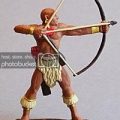
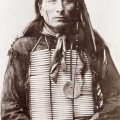
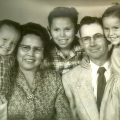
Leave a Reply